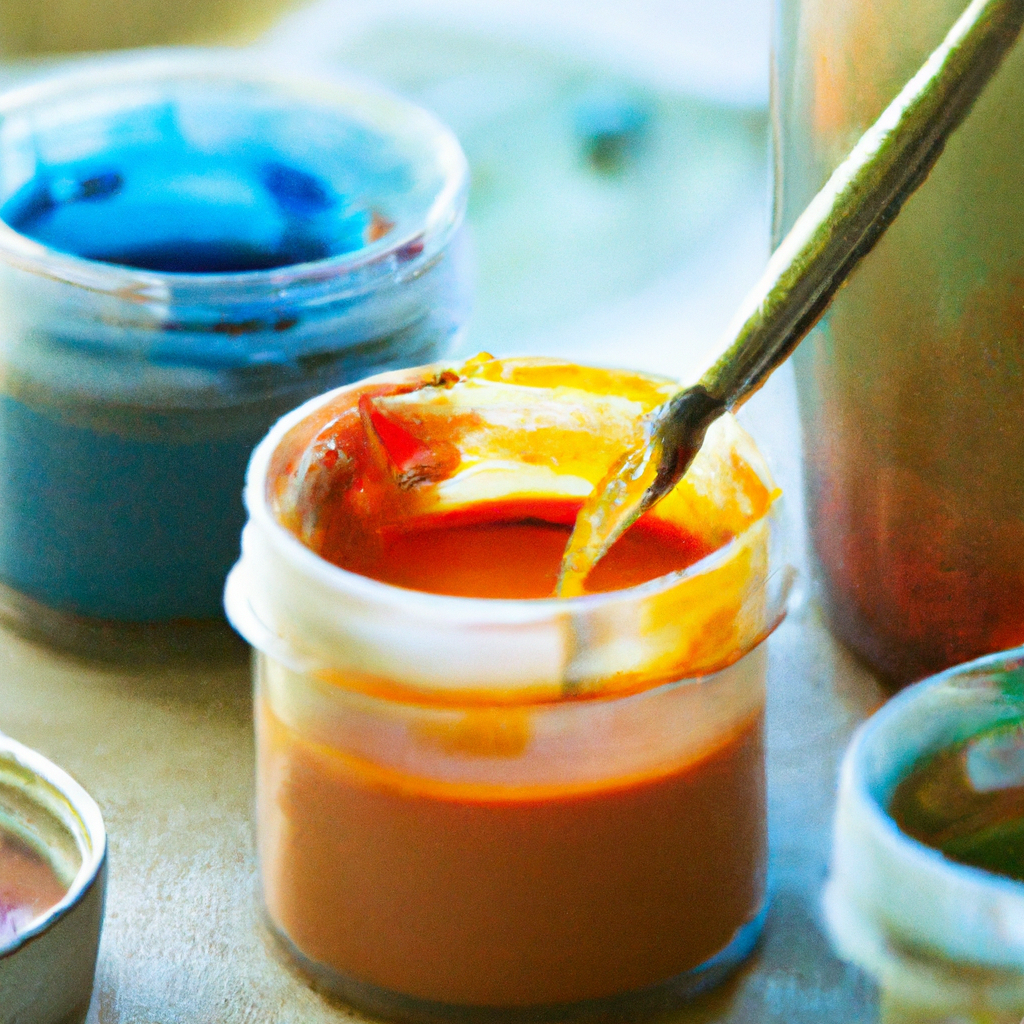Have you ever wondered what holds acrylic paint together? In this article, we will explore the essential component that acts as the binder for acrylic paint. Understanding the role of the binder can greatly enhance your painting experience and help you achieve the desired results with this versatile medium. So, let’s dive into the world of acrylic paint binders and discover the key to unlocking your artistic potential.

Overview of Acrylic Paint
Acrylic paint is a versatile and widely used medium in the world of art. It offers a plethora of possibilities for artists due to its unique properties and characteristics. Before diving into the importance of binders in acrylic paint, let’s start with an understanding of what acrylic paint actually is.
Definition of Acrylic Paint
Acrylic paint is a type of water-based paint that is made up of pigment particles suspended in a binder. This binder is what gives the paint its adhesive and cohesive properties, allowing it to adhere to various surfaces and maintain its integrity over time.
Composition of Acrylic Paint
The composition of acrylic paint consists of finely ground pigment particles that provide the color, and a binder that holds the pigments together and enables them to adhere to a surface. Additionally, there are other components in acrylic paint, such as additives and fillers, which can affect its performance and characteristics.
Properties of Acrylic Paint
Acrylic paint boasts several remarkable properties that have contributed to its popularity among artists. It dries quickly, allowing for efficient layering and faster completion of artworks. It is water-resistant and dries to a flexible, durable finish, which ensures the long-lasting quality of the artwork. Acrylic paint also offers a wide range of colors and can be easily manipulated with various techniques, making it a versatile choice for artists of all skill levels.
Importance of Binders in Acrylic Paint
Now that we have a general understanding of acrylic paint, it’s time to delve into the significance of binders in this type of paint. The binders play a crucial role in the overall performance, durability, and versatility of acrylic paint.
Explanation of Binders
Binders are chemicals that act as a glue, binding the pigment particles together and creating a cohesive paint film. They are responsible for the adhesive properties of the paint, ensuring that it adheres properly to the painting surface. Without binders, the pigments would not stay together and would simply fall off the surface.
Function of Binders in Acrylic Paint
The primary function of binders in acrylic paint is to provide adhesion and cohesion. They allow the pigments to adhere to various surfaces, including canvas, paper, wood, and even metal. Through their cohesive properties, binders hold the pigments together in a stable form, preventing them from separating or cracking.
Impact of Binders on Paint Performance
The choice of binders in acrylic paint can significantly impact its performance and characteristics. Different binders have varying properties, such as drying time, flexibility, and durability. The type and quality of binders used in acrylic paint can determine its resistance to cracking, color retention, and overall longevity.
Types of Binders Used in Acrylic Paint
There are various types of binders used in acrylic paint, each with its own unique properties and advantages. Understanding these types can help artists make informed decisions when choosing their preferred acrylic paint brands.
Acrylic Polymer Binders
Acrylic polymer binders are the most commonly used binders in acrylic paint. They are based on a type of plastic known as acrylic polymer emulsion. Acrylic polymer binders offer excellent adhesion, flexibility, and water resistance, making them suitable for a wide range of surfaces and techniques.
Polyvinyl Acetate (PVA) Binders
Polyvinyl Acetate (PVA) binders, also known as vinyl acetate copolymers, are another type of binder used in acrylic paint. They provide good adhesive properties and offer a more affordable option compared to acrylic polymer binders. However, PVA binders may not have the same level of durability and water resistance as acrylic polymer binders.
Polyethylene Glycol (PEG) Binders
Polyethylene Glycol (PEG) binders are occasionally used in acrylic paint formulations. They offer good flow and leveling properties, making them suitable for techniques that require smooth and even application. However, PEG binders may have limitations in terms of durability and resistance to aging.
Cellulose Binders
Cellulose binders, derived from cellulose fibers, provide a more environmentally-friendly option for acrylic paint. They offer good adhesion and moderate water resistance. Cellulose binders are often used in eco-friendly and natural-based acrylic paints.
Maleic Anhydride Binders
Maleic Anhydride binders are less common in acrylic paint, but they offer unique advantages. They provide excellent adhesion and resistance to high temperatures, making them suitable for specialized applications such as automotive or industrial coatings.
Other Synthetic and Natural Binders
Apart from the aforementioned binders, there are various other synthetic and natural binders that are occasionally used in acrylic paint formulations. These include polyurethane, styrene-acrylic copolymers, dammar resin, and gum arabic, among others. Each of these binders has its own set of characteristics and applications.
Acrylic Polymer Binders
Acrylic polymer binders are the backbone of most acrylic paint formulations. Understanding their characteristics and advantages can help artists make informed decisions about the type of acrylic paint they choose to work with.
Characteristics of Acrylic Polymer Binders
Acrylic polymer binders offer several noteworthy characteristics that contribute to their wide usage. They dry quickly, allowing for efficient layering and rapid completion of artworks. Acrylic polymer binders form a flexible and durable paint film that is resistant to cracking, aging, and various environmental factors. Additionally, they provide excellent color retention, ensuring the vibrancy and longevity of the artwork.
Advantages of Acrylic Polymer Binders
The advantages of acrylic polymer binders are numerous, making them a popular choice among artists. They offer excellent adhesion to various surfaces, both porous and non-porous, such as canvas, paper, wood, and metal. Acrylic polymer binders are also compatible with a wide range of pigments and additives, allowing for endless possibilities in creating different effects and textures. They are water-resistant when dry, which means that artworks created with acrylic polymer binders can be preserved for a long time.
Common Applications of Acrylic Polymer Binders
Acrylic polymer binders are incredibly versatile and find applications in a wide range of artistic and industrial uses. They are commonly used in fine art, decorative art, illustration, and even in the automotive and construction industries. Their compatibility with different surfaces and their ability to withstand various environmental conditions make them suitable for both indoor and outdoor applications.

Polyvinyl Acetate (PVA) Binders
Polyvinyl Acetate (PVA) binders, although less commonly used than acrylic polymer binders, have their own set of properties and applications worth exploring.
Properties of PVA Binders
PVA binders offer good adhesive properties, allowing for proper adherence of pigments to surfaces. They also provide decent flexibility, making them suitable for artworks that require some movement. Additionally, PVA binders have a milky appearance when wet, but they dry to a transparent or translucent finish.
Application and Use of PVA Binders
PVA binders are often used in student-grade acrylic paints and craft paints due to their affordability. They are also commonly used in schools and educational settings. Artworks created with PVA binders can be displayed indoors and are well-suited for projects that do not require high durability.
Limitations of PVA Binders
While PVA binders offer advantages in terms of affordability and initial adhesive properties, they do have limitations. PVA binders may not provide the same level of durability and water resistance as acrylic polymer binders. Artworks created with PVA binders may be more susceptible to cracking, fading, and damage from exposure to moisture.
Polyethylene Glycol (PEG) Binders
Polyethylene Glycol (PEG) binders, although not as commonly used as acrylic polymer or PVA binders, have their own distinctive features that make them suitable for specific applications.
Features of PEG Binders
PEG binders offer excellent flow and leveling properties, which means that they can spread evenly and smoothly on the painting surface. This makes them ideal for techniques that require a seamless and flawless application. Additionally, PEG binders have good viscosity control, allowing artists to achieve desired consistency and ease of handling.
Applications and Benefits of PEG Binders
PEG binders are often used in specialized acrylic paints, such as those used for airbrushing or fine detailing. Their flow and leveling properties make them suitable for creating smooth gradients and precise lines. PEG binders also facilitate better color blending and glazing techniques due to their ability to spread evenly.
Drawbacks of PEG Binders
Despite their advantages, PEG binders may have limitations when it comes to durability and aging. They might not provide the same level of resistance to cracking or color fading as acrylic polymer binders. Additionally, PEG binders may not offer the same degree of water resistance as other binder types.

Cellulose Binders
Cellulose binders are a more environmentally-friendly option in the realm of acrylic paint. Let’s explore their characteristics and uses.
Characteristics of Cellulose Binders
Cellulose binders, derived from plant-based cellulose fibers, offer good adhesion and decent water resistance. They have a lower environmental impact compared to some synthetic binders and are often used in eco-friendly acrylic paints. Cellulose binders can provide a matte finish and have a unique texture that some artists find appealing.
Uses and Advantages of Cellulose Binders
Cellulose binders are commonly used in natural-based or eco-friendly acrylic paints. Their adhesion properties allow for proper adherence to surfaces, and their water resistance ensures the longevity of the artwork. Additionally, cellulose binders can offer a more matte appearance, which may be preferred in certain artistic styles.
Disadvantages of Cellulose Binders
While cellulose binders have their advantages, they may have limitations when it comes to durability. They might not provide the same level of resistance to cracking, aging, or environmental factors as other synthetic binders. Artworks created with cellulose binders may require additional protective measures to ensure their long-term preservation.
Maleic Anhydride Binders
Maleic Anhydride binders, although less common in the realm of acrylic paint, have unique properties that make them suitable for specific applications.
Properties of Maleic Anhydride Binders
Maleic Anhydride binders offer excellent adhesion and resistance to high temperatures. They can withstand extreme heat and are often used in specialized applications, such as automotive coatings or industrial finishes. Additionally, maleic anhydride binders provide good flexibility and durability, ensuring the longevity of the paint film.
Applications and Benefits of Maleic Anhydride Binders
Maleic Anhydride binders are commonly used in industries that require paints with high-temperature resistance and excellent adhesion. They can be found in automotive paints, metal coatings, and other applications where durability and performance under extreme conditions are crucial.
Limitations of Maleic Anhydride Binders
While maleic anhydride binders offer advantages in terms of adhesion and high-temperature resistance, they may have limitations in other areas. They might not provide the same level of flexibility as other binders, which can affect their suitability for certain artistic techniques or surfaces. It is important to consider the specific requirements of the artwork before choosing a binder.

Other Synthetic and Natural Binders
Apart from the binders mentioned earlier, there is a wide array of other synthetic and natural binders that find their way into acrylic paint formulations. Let’s explore some examples and compare synthetic and natural binders.
Examples of Other Synthetic Binders
Polyurethane and styrene-acrylic copolymers are examples of synthetic binders used in acrylic paint. Polyurethane binders offer excellent durability and resistance to aging, making them suitable for artworks that require long-term preservation. Styrene-acrylic copolymers offer good adhesion and flexibility, making them versatile for various painting techniques and surfaces.
Examples of Natural Binders
Gum arabic and dammar resin are examples of natural binders used in acrylic paint. Gum arabic, derived from the sap of certain types of acacia trees, provides good adhesion and is commonly used in watercolor painting. Dammar resin, derived from the sap of certain tropical trees, offers a glossy finish and is often used in varnishes.
Comparison of Synthetic and Natural Binders
Synthetic binders, such as acrylic polymer and polyurethane, tend to offer better durability and resistance to various environmental factors. They are generally more versatile and can be used in a wide range of applications. Natural binders, although sometimes preferred for their eco-friendly properties, may have limitations in terms of durability and performance. Choosing between synthetic and natural binders depends on the specific requirements of the artwork and personal preferences.
Factors to Consider When Choosing Binders
When selecting acrylic paint, it is important to consider several factors that can impact the overall performance, durability, and suitability for your artistic needs.
Painting Purpose and Technique
Consider the purpose of your painting and the specific techniques you plan to use. Different binders offer different levels of adhesion, flexibility, and suitability for various techniques. Understanding how each binder interacts with the chosen surface and the desired effect can help you select the right one for your artwork.
Surface Compatibility
Different surfaces, such as canvas, paper, wood, or metal, may require specific binders for optimal adhesion and longevity. Consider the compatibility of the chosen binder with the surface you plan to work on to ensure proper adhesion and prevent any potential issues in the future.
Drying Time
The drying time of acrylic paint can vary depending on the binder used. Some binders, like acrylic polymer, have a relatively fast drying time, while others may dry more slowly. Consider the desired working time and the speed at which you want to layer or manipulate the paint.
Flexibility and Durability
Consider the flexibility and durability required for your artwork. Different binders offer varying levels of flexibility and resistance to cracking or aging. If longevity is a concern, opt for a binder that provides excellent durability, especially if your artwork will be exposed to environmental factors or regular handling.
Toxicity and Environmental Impact
Be aware of the toxicity of binders and their impact on the environment. Some binders may contain certain chemicals that can be harmful if ingested or inhaled. Additionally, some natural binders may offer a more eco-friendly option, making them suitable for artists concerned about minimizing their environmental footprint.
In conclusion, binders are an essential component in acrylic paint, serving the important function of holding the pigment particles together and providing adhesion to various surfaces. Acrylic polymer binders are the most commonly used, offering excellent durability and versatility. Other binders, such as PVA, PEG, cellulose, and maleic anhydride, have their own unique properties and find applications in specific artistic or industrial uses. The choice of binder depends on various factors, such as desired techniques, surface compatibility, adhesion, flexibility, and environmental considerations. By understanding the different types of binders and their characteristics, artists can make informed decisions when selecting acrylic paints for their creative endeavors.




